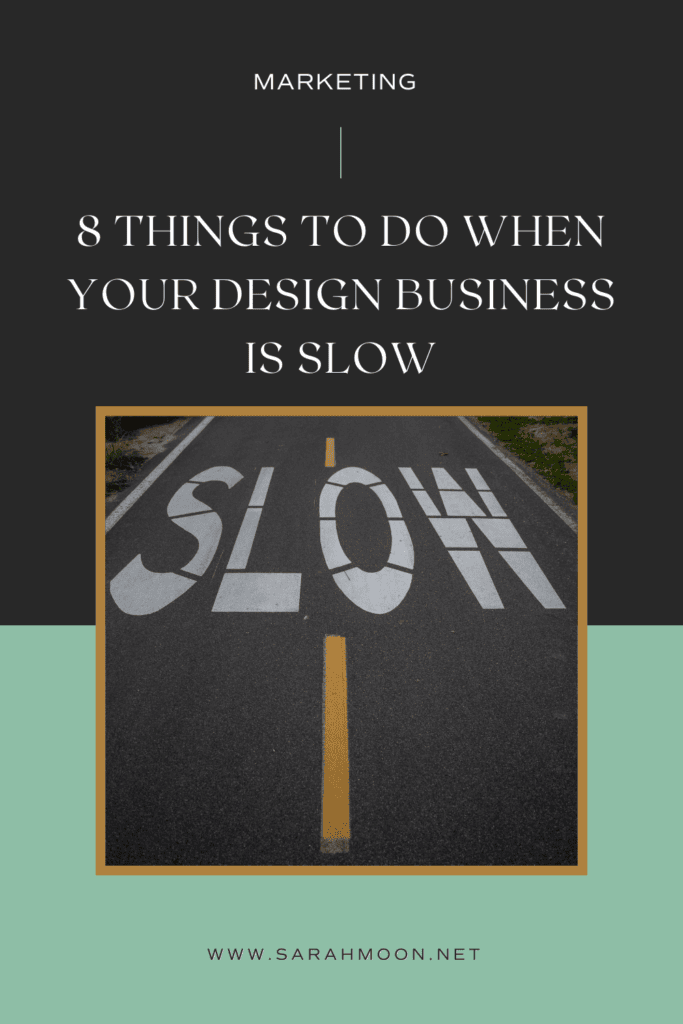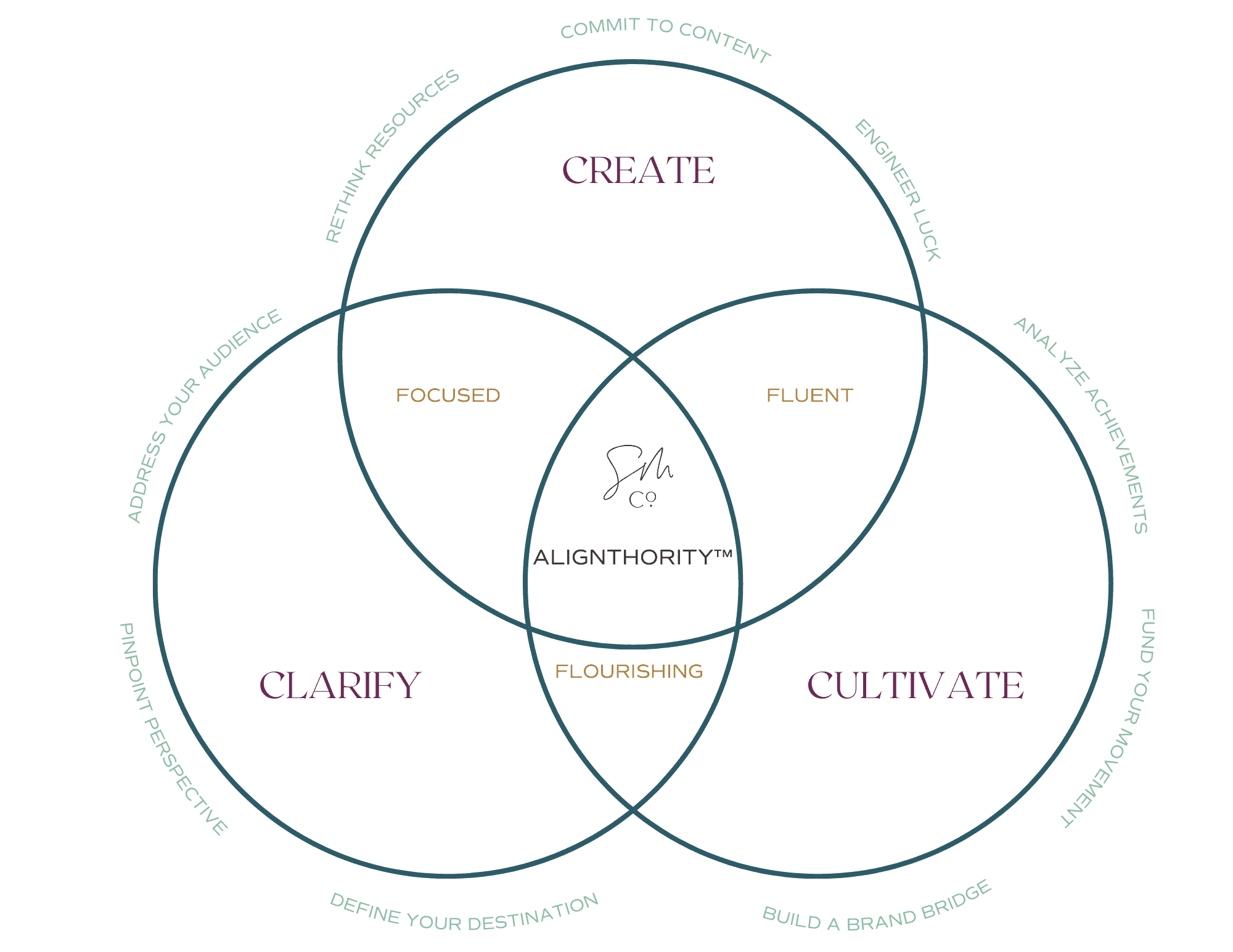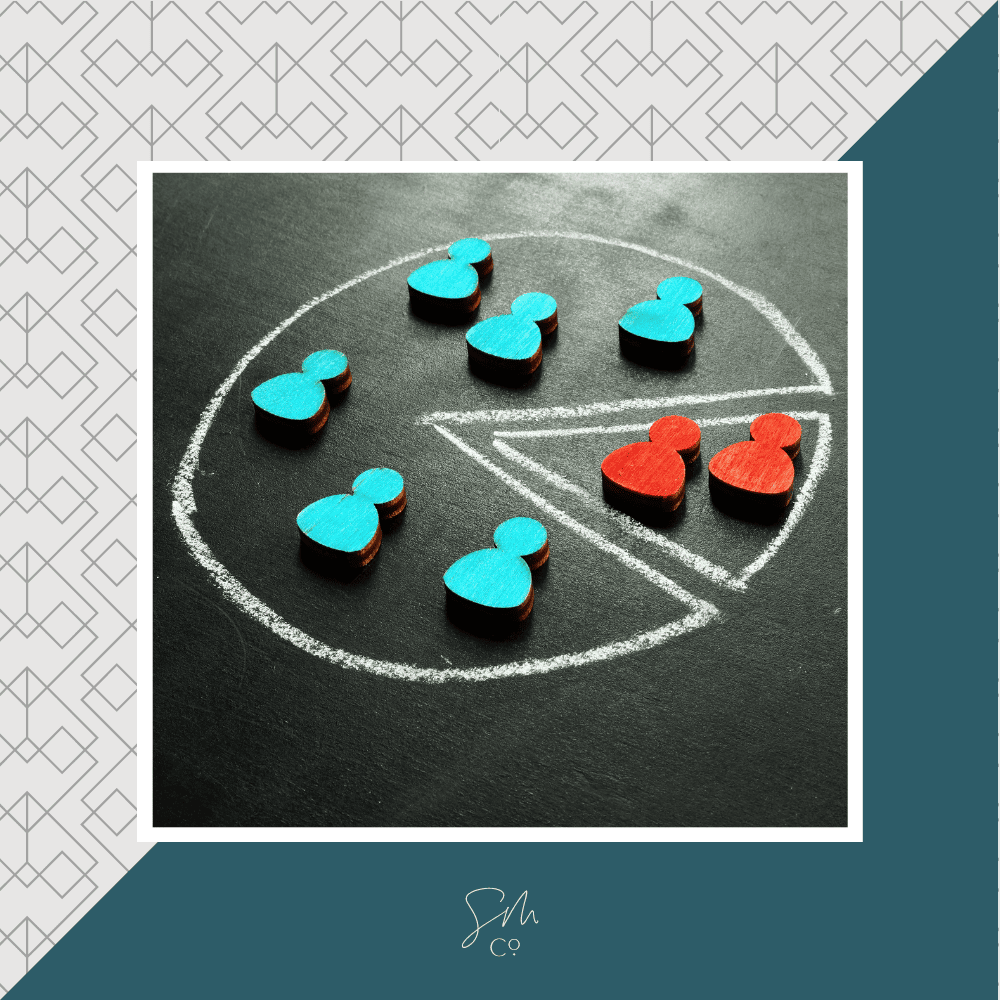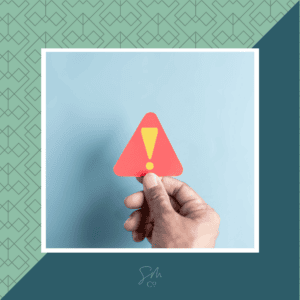- 1. If you’re getting more “noes” than “yeses” in response to your design proposals, it is time to get serious about your unique difference.
- 2. To help clients decide that your design services are for them—center them in your marketing and messaging.
- 3. Do direct outreach to design leads who said “not right now.”
- 4. To get more revenue flowing again in your design business, don’t neglect past clients.
- 5. If design business is slow, finally commit to email marketing — and don’t forget to segment your past clients.
- 6. Take this extra time to write high quality, industry-specific design case studies that explain the client’s results, in language they understand.
- 7. Offer short 1:1 support sessions to both new and old clients with website updates and strategy.
- 8. Consider a limited time cash infusion offer in your design business that’s exclusive and very tight in scope.
Despite all your talent and training, sometimes the web and graphic design business is slow. There are lots of reasons for this: your marketing has slowed, the industries you serve have natural seasonal fluctuations, there are global economic forces at play, or even the way people buy has changed (my colleague LeighAnn wrote a great article about this recently).
Whatever the reason, you should not and cannot just sit and wallow and worry—action is a non-negotiable to keep a slow season from becoming a full-blown crisis in your design business.

I speak from the experience of running a successful small design agency (and before that a freelance design career) and advising many creatives in my Spark Sessions and Business Mentoring programs. When I say I’ve seen it all, I mean it—trust me, whatever is happening in your business, you’re not alone and other designers have weathered this storm. (And so can you!)
1. If you’re getting more “noes” than “yeses” in response to your design proposals, it is time to get serious about your unique difference.
Designers and other creatives love to believe that their work speaks for itself. I wish this were true, I truly do. But the reality is that clients aren’t knowledgable to determine if your high quality work is any better than the next designer. They like what they see or they don’t—which is personal preference and taste at work.
To bust out of the work comparison trap, you need to stand out in terms of your methods, perspective, and difference. For example, my client Nic, a web designer in Sydney, Australia, has a signature method called “Design Your Clever Business,” which is “the result of years of experience helping professionals design flexible, sustainable and resilient businesses.” This framework speaks directly to clients’ need to be flexible and nimble in their marketing and makes her services the logical solution for those clients when everyone else is talking about features not results.
Here’s my own signature Alignthority™ system, visually represented with a Venn diagram:

2. To help clients decide that your design services are for them—center them in your marketing and messaging.
When I review designers’ websites, one of the most common opportunities I see is making a shift from “I” to “you.” So many designers are focused on their work, their credentials, their experience, that they forget to speak directly to what’s in it for the client.
For example, a brand designer could make this shift:
Before (I language): “I specialize in logo design and can create a unique visual identity for your brand.”
After (You language): “A memorable logo sets your brand apart and makes you unforgettable to your target audience.”
Now, before you scream at me, “I don’t just design logos!” I agree, you don’t. But your client does not understand the difference between a brand and a logo—it’s up to you to help them learn that, but you need to start with their language. You language isn’t just talking to them, it’s meeting them where they’re at.
Shifting your communication to “you” language puts the focus on the client’s needs and desires.
Here’s how in three simple steps:
- Highlight Benefits: Instead of saying “I offer branding services,” say “When you elevate your brand, you’ll attract a whole new level customers.”
- Create Openness: Change “I’m happy to answer questions” to “Get the clarity you need.”
- Build Trust: Move from “I have 10 years of experience” to “Benefit from my decade of experience creating impactful designs across industries.”
Language matters—paint the picture for your potential clients about what’s in it for them. Remember that brands and websites are some of the biggest investments clients make in their businesses so your job is to make them feel confident!
3. Do direct outreach to design leads who said “not right now.”
Designers tend to hear “not right now” as “never.” The reality is that stuff happens, projects move to the next quarter or even the following year. If you got a “not now,” it’s time to follow up. Yes, follow up is scary. No you’re not being salesy. You’re maintaining a connection.
Here’s an example email you can adapt (please don’t use it verbatim—you need to sound like you!):
Hello [name],
We previously connected about [mention the original project or service you discussed], and while things didn’t move forward at the time, I wanted to reach out with something that might be valuable.
I recently published an article on my website about [subject] and it reminded me of our conversation back in [month]—I thought it would be a good resource for you as you plan your new website.
I’d be happy to chat further about how this approach can be applied to your specific business goals – feel free to reach out if you have any questions.
Warmly,
[Your Name]
You may be surprised how many of these cold leads reply with a, “I’ve been meaning to reach back out!” This happened many, many times when we were designing websites week in and week out.
4. To get more revenue flowing again in your design business, don’t neglect past clients.
Past clients regularly need more help, support, and advice. If you don’t have a regular schedule of updates or strategy you provide to former clients, you’re running your business on hard mode.
These are the folks who have already experienced the value you bring to the table as a designer and trusted advisor. They trusted you with their project and you delivered something amazing. Re-engaging with them can be a fantastic way to reignite revenue and secure new work.
Reaching out is easy, but you need to do it directly and in a personalized way.
- Reach out and reconnect. A simple email (adapt the one above for cold leads) can go a long way. Express your appreciation for their past business and share a resource that’s relevant to them.
- Offer exclusive packages or discounts. Show your past clients some love by creating special offers targeted to their needs. This could be a discount on a new project, a free consultation, or a loyalty program. When we ran our highly successful Design in a Day™ program, our “alums” got access to a special rapid-paced updates program with a structure similar to what they experienced previously. We made it so easy to book that it was just “pick your day and pay” through our Acuity calendar.
- Highlight new services. Have you expanded your design offerings since you last worked with a client? Let them know! They may not be aware of all the ways you can now assist them. This was something that worked well for me when I transitioned the design agency to a marketing strategy consultancy. Some of my first Spark Sessions clients were old web design clients—how cool is that?
- Showcase their success stories. Past client testimonials and case studies can be powerful tools. Share them in your outreach to demonstrate the value you delivered and spark their interest in working with you again. Tag them on socials, link to their sites in your portfolios, celebrate your clients!
By nurturing relationships with past clients, you’re not just rekindling old connections, you’re tapping into a warm market of potential repeat business. So next time your cash flow feels sluggish, remember: your most valuable clients might already be your clients.
5. If design business is slow, finally commit to email marketing — and don’t forget to segment your past clients.
This is a medium-term strategy, so don’t expect it to turn business around today. However, the vast majority of designers I’ve worked with are not great with the highest return on investment, email marketing. For every dollar invested in email marketing, the return is $36, according to Litmus!
The magic of email marketing is that it goes straight to where your clients are most engaged: their inboxes.
Here are a few email marketing rules I live by, as someone who successful sold website design and now marketing strategy services through email marketing:
- You must send an original email at least once a week—this means your audience, using industry standard assumptions, will see your emails at least once a month.
- Banish the monthly magazine style email that designers love—your clients do not want to read a magazine about design in their inbox once a month. Yes, I know you love this format, but they do not. Ask them if you don’t believe me.
- Provide valuable information, insights, and updates that your services can solve. Don’t get too technical, but do surprise them with things they may not know.
- You must have a welcome sequence and introduce your uniqueness, your framework, and your methods to new members of your audience.
- Don’t worry too much about the tech, pick a platform from our guide and get started.
6. Take this extra time to write high quality, industry-specific design case studies that explain the client’s results, in language they understand.
Too many designers’ case studies are jargon-filled and once again leave clients choosing what they like taste-wise, and not the designer who can best solve their problems. We choose to write narrative, client-centered case studies, but there are many, many ways to tell the story of your work without being stuck in the weeds.
If you’re looking for examples, my client Nic’s case studies are full of inspiration, as are my client Elliott’s. Another resource I love is my colleague Danbee Shin’s excellent Case Study Recipe course.
I cannot tell you the number of folks I’ve worked with who’ve told me they’ve lost out on opportunities because they didn’t have case studies—just do it and then repurpose them in your newsletter, proposals, and social media marketing.
7. Offer short 1:1 support sessions to both new and old clients with website updates and strategy.
I love “one hour things” as a way to 1) build a client base and 2) bring in regular cashflow. Mine come in the form of my strategy consultations, but you could offer a Canva power hour to organize and implement branding on Canva live on Zoom or you could have a live site updates session (I sold these successfully for years) or you could do a quick hit SEO spiff up on a call with a client.
The secret here is that these sessions are time blocked and only require “thank you” level follow up, not loads of documentation. You want to ensure they’re profitable and efficient and definitely follow up with these folks in the future using my template in my third tip.
8. Consider a limited time cash infusion offer in your design business that’s exclusive and very tight in scope.
I don’t love people creating new services when they need cash. It creates a slew of problems, particularly in terms of needing to create new systems, processes, and documentation. There are bumps you don’t need when you’re in the midst of stress already.
However, I have successfully created a one-time cash infusion when I had the design agency and I’d love to share some tips about what worked when we sold $25,000 in design services in about 36 hours with one of these offers.
- We analyzed what our top requests were and determined they were updates and SEO implementation
- We pulled documentation for both of those services and reviewed them
- We then outlined a pared down process that would incorporate both services but in a limited scope and very fixed process (no modifications were allowed)
- We sold that combination offer as a one time only productized service
- We did not offer sales calls for this, it was all through emails and voice notes (I could have sold more if I’d done sales calls, but the spots were limited and they sold out)
- This service was offered on a first come, first served solution and we automated most of the workflow on the client side using Dubsado (this link gets you a 20% discount as I’m an affiliate)
- We created a scheduled follow up for those clients to continue the conversation after their project launched and highlighted many of them on our social media
If you’re going to take this approach, my biggest piece of advice is to make sure you can deliver everything you’re selling on time and exceeding your clients’ expectations. Otherwise you can ruin your reputation and credibility with a cash infusion offer.

What’s your next marketing move?
Take our quick assessment designed to help you prioritize the best next step in your marketing strategy. No fluff, all action—the Aligned Authority way!
Don’t let a lull in projects derail your design career. While a slow period can be frustrating, it’s also an opportunity to refine your approach and finally get serious about marketing. It’s also not time for a pivot or new direction:
1. When business is slow, do not launch a “replace me” course.
I’ve seen way too many designers launch courses thinking they can recoup lost revenue by teaching people to be design websites themselves. If your passion lies in teaching, go for it, but this is very rarely the case for designers.
Furthermore, courses are a hard sell. You need a sizable audience to make meaningful revenue and you most definitely need demand for the course—and rarely is there for this sort of thing.
2. Similarly, when demand for your design services wanes, do not discount your prices!
Many designers lower their prices when business slows and this simply doesn’t work. Know what happens instead? They have the same number of clients but make less money, which perpetuates the problem. You’ve also lowered the anchor for your services, which means you’ll have even more challenges adjusting prices in the future. Frankly, I’d consider raising prices if tinkering with pricing makes sense during a slump—you may reach a more affluent audience that’s less price sensitive.
The Takeaway: When Design Business is Slow
If you take nothing else from this article, I want you to hear this:
A lull in client work doesn’t have to spell disaster for your design business.
It’s an opportunity to refine your approach, strengthen your marketing efforts, and reconnect with valuable clients.
By implementing thoughtful strategies, you can transform this temporary hurdle into future success. Remember, a thriving design business is built on a foundation of strong client relationships, targeted marketing, and a unique value proposition. Embrace this slow period as a chance to solidify these cornerstones, and you’ll be well-positioned to weather any storm and emerge with a design business that flourishes.
Did you enjoy this article? These may also help you re-energize your design business:
Is it possible to market your business without social media in 2024?
Are you curious about marketing your business outside of social media? Read our how to guide to doing just that!…
The No-Nonsense Guide to Hiring an SEO Expert in 2023
If you’re focused on increasing your visibility online, growing your revenue, or diversifying your lead generation, SEO is likely a…
What is movement marketing?
Movement marketing is often misconstrued and deeply misunderstood. Learn what it really means and the five fundamentals behind this marketing…
The Ultimate Guide to Identifying Your Consulting Niche (Plus: 6 In-Demand Consulting Niches for 2024)
Ready to develop an in demand and thriving consulting practice? Our guide—written by someone who’s been there, done that, walks…
The Expert’s Guide to Thought Leadership Marketing: Surprising Tips for Accelerating Your Visibility
Ready to own your voice and leverage thought leadership as a marketing strategy? Read our guide to learn how this…
How to Build a Bold Personal Brand as a Consultant
The secret to being the first and only choice in your industry? Building a bold and purposeful personal brand as…
Four Frameworks to Fuel Your Marketing & Business Strategy
Have you codified the vision for your business? If not, you’re not alone! Dig into four you can use right…
Productized Services vs Intensives vs VIP Days
Learn exactly what productized services and day rates are and how you can implement these models into your business….














 & Our Favorite Portland Coffee Shops
& Our Favorite Portland Coffee Shops